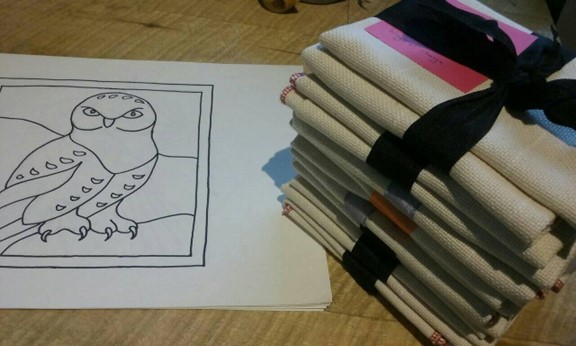A Nurturer’s Heart

It was pretty darn cold on the farm yesterday morning, as I packed up the supplies. One of my hilarious nicknames is “Lady Lugs-a-lot,” because it seems that, no matter where I go, I’m hauling something from point A to point B—usually armloads of something. If it’s not bins of wool roving for a needle felting class, it’s crates of frozen meats for the next delivery run, eggs for candling and packaging for the shop, or instruments for the next jam session.
Today, it was an armload of ironed 24×24 inch pieces of monk’s cloth and a handful of my own drawings for an upcoming punch needle rug hooking class at North House Folk School in Grand Marais, MN. Two years ago, I’d been a student there at a millinery class. Now I was going to have my own room full of eager students during their renowned Fiber Week retreat.
I was making the haul to Farmstead because I use the top of our bakery case as a light table, laying out first the hand-drawn pattern and then the fabric, tracing the lines through. The fabric will serve as a backing for my students—like a stretched canvass on which the colorful wool yarns are then punched through in loops to create the design, rather like a Berber carpet.
Last Saturday, during our Community Dinner and Jam Session, I was chatting with my friend Shivawn about life and happenings and reminiscing about old teachers. “You know,” she chuckled, remembering a dreaded math teacher, “Just because you’re good at doing something doesn’t mean that you’re a good teacher.”
That phrase stuck with me for the week, as I mulled over what it is that makes a good teacher or educator, which landed me on the thought of having a nurturer’s heart. As if the universe was asking me to solidify this idea, Minneapolis’ Text Center (at which I’ll be teaching needle felting in March) sent me an instructor’s survey on my teaching style. Here are some of questions and my responses.
What is your teaching philosophy or style?
I love opening doors to new worlds for creative expression, encouraging students to explore and bloom. For me, it’s a midwifing process, whereby we take the journey together with encouragement and active demonstration.
How did you get introduced to the fiber arts, and how has this interest developed?
My fiber arts story is many streams in a river, but I remember learning to crochet from my mother by at least age 8. Sewing skills were also passed down through the generations in the family. At age 13, I began 5 ½ years of mentorship with master Navajo weaver Fran Potter in Madison and have taken on many mediums since, including via my MFA.
Can you share a meaningful experience that affirmed your desire to teach?
I’ve now taught over 80 needle felting classes and have seen many students struggle with inhibition or self-doubt in the creative process. When you can unlock the magic and step through the talons of the inner critic, then the euphoria of creative liberation fills the room. I teach to unlock that magic!
What does your own studio practice look like, and how does this inform your teaching?
My practice is remarkably interdisciplinary, and I typically have at least 30 pieces in various stages of completion. My family is very patient with me as projects are almost everywhere in our home! Yet, often when working on one, my subconscious is working through a problem on another project until the “aha” moment hits—we all have different pacing.
Why should students register for this class?
If you’re interested in taking your needle felting process to a new level or exploring the idea of “painting with wool,” this class is designed to help you learn not only color blending and shape creation but also composition, layering, and bead embellishment. Come ready to play with the materials in an encouraging, facilitative environment.
**
A nurturer’s heart works beyond the lecture hall at the ground level, individually or in small groups, side-by-side with the student. She wishes the best for her students, encouraging their growth as an individual. She is the mentor, the coach, the hand-holder, the facilitator. The nurturer wishes to make a positive impact for those around her, not through the grandiosity of fame but through the ripple effect of personal engagement with her students—real people with names and faces.
If you too have a nurturer’s heart, you will recognize these values right away! If winter has you feeling like you need to spend some time learning something new in a nurturing environment, seek out this type of teacher or mentor. Look up courses offered at folk schools or other hands-on inspired learning environments. I have fiber arts classes happening at Farmstead Creamery nearly every week (see our farm’s event calendar on our website or Facebook pages), as well as my travel teaching. It’s part of our farm’s mantra to inspire, empower, and renew.
Through the ripple effect of nurturing ourselves and each other, we serve as positive, affirming forces in a world fraught with division, conflict, and despair. Keep up the good work, nurturers! See you down on the farm sometime.





